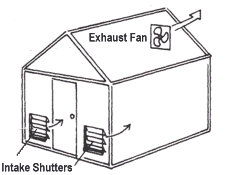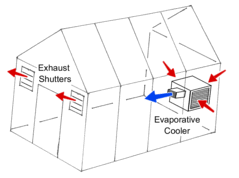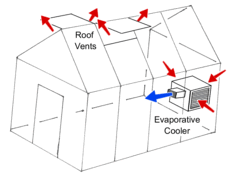Greenhouse Supplies Guide
Ventilation / Cooling
Ventilation is the single most important requirement for a greenhouse. It has two important purposes: providing fresh air, mainly carbon dioxide, to plants and cooling for the greenhouse. Without good ventilation, a greenhouse is nothing more than a solar furnace. Greenhouses are really designed to store heat from the sun during the day creating a warmer temperature in the greenhouse versus outside of it. This makes cooling a greenhouse on a hot day a difficult task that can not be accomplished without a good ventilation system. Cooling in the summer can be accomplished most easily with a combination of shade, proper ventilation, and an evaporative cooling system like a misting system, fogger, or evaporative cooler. Shading and evaporative cooling are discussed below. Even using all of the items mentioned above you can expect a greenhouse to still not be much cooler if any than the outside temperature in hot humid areas.
 An exhaust fan ventilation system usually consists of a fan setup to blow hot stale air out of the greenhouse and bring fresh cooler air inside the greenhouse via intake shutters mounted on the opposite end of the structure (Shown in picture). Plants require fresh air year round which is why it is important to have equipment with options like louvered fans, motorized shutters, and variable speed motors that will help prevent heat loss when it is cold outside. An exhaust fan system should be able to make a complete change of air in 1 to 3 minutes (about 1 minute or less for small greenhouses, 2 to 3 minutes is acceptable for large commercial size greenhouses) in summer to keep temperatures in the greenhouse at a reasonable level. If you aren't sure what size fan or shutters you need, use our Fan & Shutter Size Calculator.
An exhaust fan ventilation system usually consists of a fan setup to blow hot stale air out of the greenhouse and bring fresh cooler air inside the greenhouse via intake shutters mounted on the opposite end of the structure (Shown in picture). Plants require fresh air year round which is why it is important to have equipment with options like louvered fans, motorized shutters, and variable speed motors that will help prevent heat loss when it is cold outside. An exhaust fan system should be able to make a complete change of air in 1 to 3 minutes (about 1 minute or less for small greenhouses, 2 to 3 minutes is acceptable for large commercial size greenhouses) in summer to keep temperatures in the greenhouse at a reasonable level. If you aren't sure what size fan or shutters you need, use our Fan & Shutter Size Calculator.
Many people use roof and/or side vents to supply fresh air to plants and cool their greenhouse. This is ideal for venting during cold months, because if used with automatic vent openers, fresh air can be supplied to plants gradually reducing any "temperature shock" to plants. HAF circulation fans are highly recommended for use with side and/or roof mounted vent systems. These fans move air throughout the greenhouse eliminating hot and cold spots which is useful when venting or heating your greenhouse. The increased air movement helps to expel hot air out of the window vents and provide fresh air for plants. If additional air movement and/or cooling is needed, an evaporative cooler should be installed. They provide active ventilation like a fan system bringing in cooler air down low and exhausting the hotter air through existing roof vents. Evaporative coolers can also be used with exhaust shutters like in the diagram below. NOTE: Exhaust fans are not recommended for use with roof vent systems. The fan disrupts the natural release of hot air through the vents and pulls in outside air through the closest open vent instead creating stagnant air and hot spots on the opposite end of the greenhouse.

|

|
| Cooler with Exhaust Shutters
|
Cooler with Roof Vents
|
Unless you plan on staying in your greenhouse 24 hours a day 7 days a week, you should consider automating your ventilation system. Forgetting to vent your greenhouse one hot day could fry every plant in it. Thermostatic controls and solar powered autovents will also maintain a more consistent temperature in your greenhouse which promotes healthier plant growth. In hot climates shading and misting equipment may be necessary to hold the greenhouse's temperature in check. Winter ventilation needs are lower.
Heating
The heating requirements of a greenhouse depend on the desired temperature for the plants grown, the location and construction of the greenhouse, and the total outside exposed area of the structure. Much of the daily heat requirement may come from the sun, but if you want your greenhouse to be more than a few degrees above the outside temperature at night, you will need to provide it with a heat source. The heating system must be adequate to maintain the desired day or night temperature. Heating systems can be fueled by electricity, gas, oil, or wood. The choice of a heating system and fuel depends on what is locally available, the production requirements of the plants, cost, and individual choice. Heating requirements for your greenhouse can be determined with our Heater BTU Calculator.
If you're using your greenhouse to start seedlings and root cuttings in the spring, supplemental heating probably will not be necessary. In mild climates, 12' x 12' and smaller model hobby greenhouses can be adequately heated with electric heaters (make sure electric heaters are not exposed to water to avoid a dangerous shock). An electric heater is clean, efficient, and easy to install and maintain. Small gas heaters will also work well in hobby greenhouses. With larger size greenhouses and cold climates where temperatures regularly fall below freezing, larger gas greenhouse heaters are most commonly used because it is cheaper to heat with gas than electric in most areas. A highly recommended item for use with any greenhouse heating system is a heat circulation fan. They gently move the hotter air in the peak of the greenhouse to plant level helping to maintain an even temperature in the greenhouse and increasing the efficiency of your heating system.
For safety purposes, and to prevent harmful gases from contacting plants, all gas, oil, and wood burning systems must be properly vented to the outside. Use fresh-air vents to supply oxygen for burners for complete combustion. If you use an unvented gas heater in your greenhouse, it is recommended that natural "indicator" plants like tomatoes, impatiens, and salvia be placed near the heater. These plants are very sensitive to gases produced from combustion in gas heaters and will have malformed leaves and stems and/or prematurely lose flowers before other plants if the gases are not being vented properly. Also, look for safety features like automatic overheat controls when purchasing a heater. Portable kerosene heaters used in homes are risky because some plants are sensitive to gases formed when the fuel is burned.
Misting and Watering
Misting and fog systems have a variety of uses in a greenhouse. It is important to determine what you want to accomplish with a misting system before purchasing one.
Humidity: It is important to maintain a healthy humidity level (50% to 70%) in a greenhouse. This is healthy for the plants and higher humidity levels also helps reduce the watering frequency of plants in the greenhouse. When the greenhouse is vented, essential moisture is lost, and plants are more likely to dry out and wilt. Fog and Misting systems with fine nozzles are very effective at providing additional humidity because their smaller water particles evaporate more quickly.
Evaporative Cooling: Misting systems are a great low cost solution to help cool greenhouses with a fine mist that lowers air temperatures when it evaporates. Smaller nozzles work best for cooling also. The down side to misting is not all of the mist will evaporate, and water will collect on plants (This is a desired effect if you want to mist in plants and provide cooling). An evaporative cooler is the most effective cooling solution offered other than installing an air conditioning system. It is a closed system that keeps water inside the cooler and only exhausts the cooled air into the greenhouse.
Watering: Cuttings and seedlings are commonly watered with small overhead sprinkler or misting systems or mist nozzles for hoses because watering with a regular wand or watering can may disturb the surrounding soil causing plants to take longer to root. If a misting system is used, larger misting nozzles like our 3 gph poly mist nozzles are needed for cuttings and seedlings to make sure the soil is properly saturated. Overhead sprinkler systems are useful for watering most types of established plants in a greenhouse as well. Drip systems are an effective way to water larger plants without wetting the foliage. Another advantage to drip systems is that they use very little water when compared to overhead watering systems.
Shading
Shade covers are the way professional growers keep their greenhouses cool during those long hot summers. They block a percentage of the sun's rays from entering the greenhouse which can reduce temperatures over 20% alone. Shade covers are relatively inexpensive and also provide shade for plants that don't grow well in full sun. The amount of shading necessary varies depending on greenhouse location, your local climate, and the light requirements of the plants in the greenhouse. Most greenhouse shade cloths fall in the 45% to 70% shade range. When buying a shade cover remember, more is not always better. Excessive shading can slow plant growth and cause plants to stretch.
Flooring
The floor of your greenhouse is both functional and aesthetic. It forms the surface you walk on and helps complete the image of the greenhouse. The walkway and the area under the benches are usually two different materials. The walkway should form a firm nonskid surface for walking, be easy to clean, and be durable enough to withstand constant moisture and dirt. Common materials used for a walkway include concrete, brick, stone, gravel, wood slats, and ground bark. The area under the benches is usually covered by a porous material that can be dampened to help provide humidity and should allow easy drainage of water. For under bench areas, consider gravel, sawdust, ground bark, or any other porous material. You will want to lay a sheet of woven weed barrier (ground cover) under the floor covering to prevent weed growth, because weeds harbor many pests and diseases. For more information, take a look at our guide on building a foundation and floor.
Benches
You will want benches in your greenhouse. They make a world of difference in the ease of gardening and add a lot of extra working space to your greenhouse. Benches also provide the area under them with plenty of shade which is an ideal environment for many plants. Greenhouse bench tops should have an open design which allows water to drain and fresh air to flow through them.
Lighting
If your growing area or the season does not provide your plants with enough light, you may need to provide artificial lighting. For detailed information about artificial lights and options available, you can visit our Grow Light Guide.